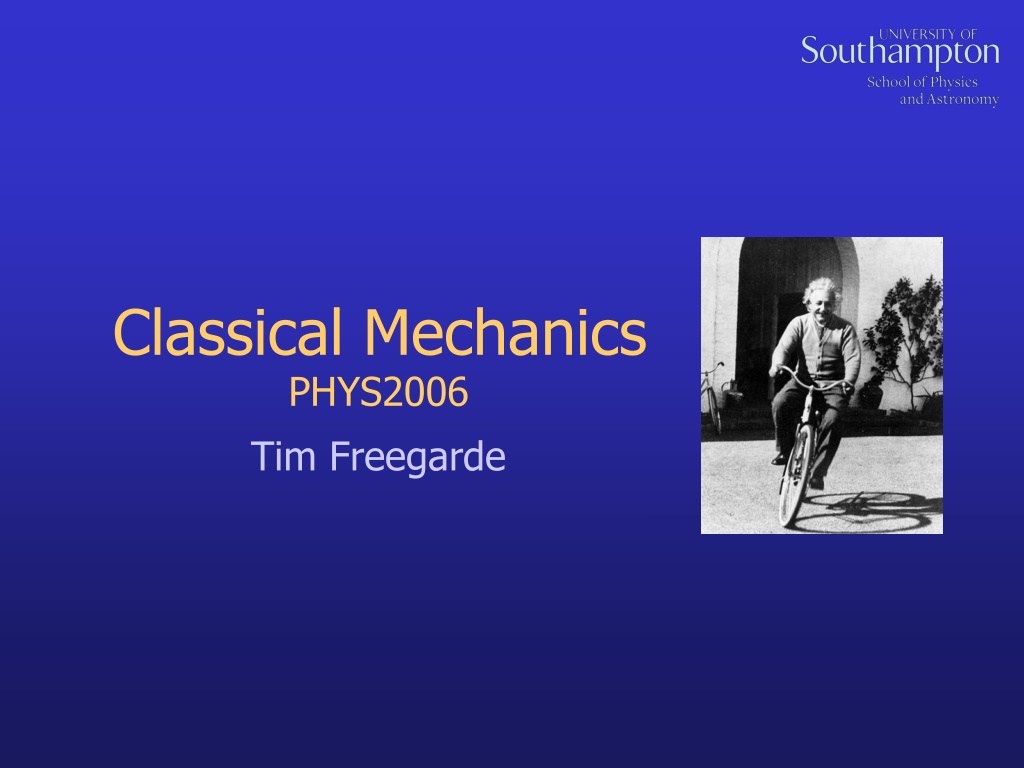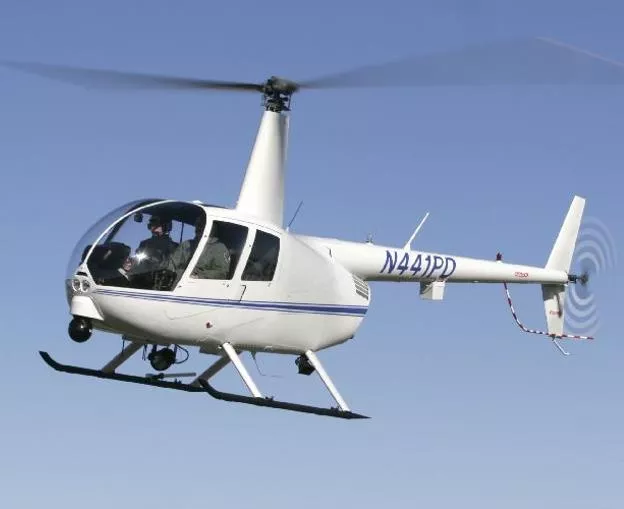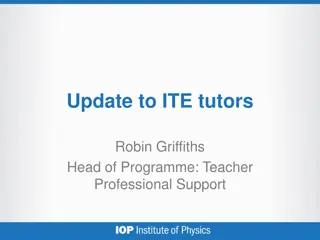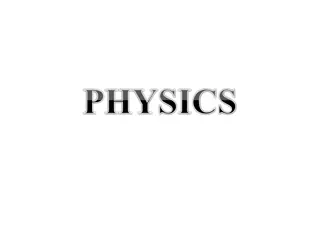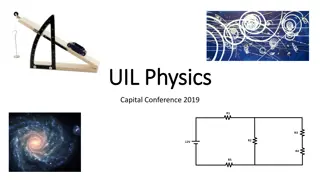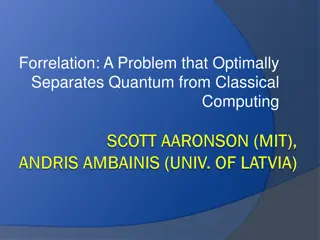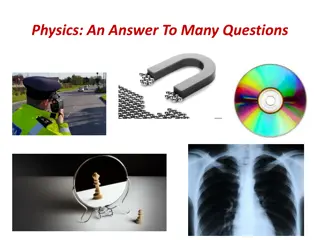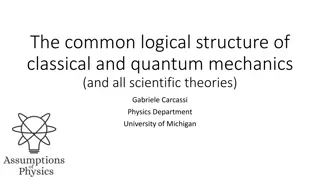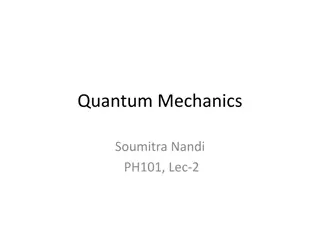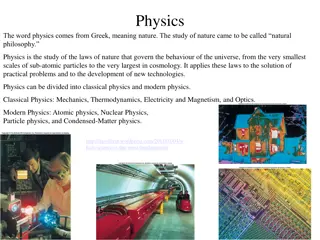Classical Mechanics in Physics
Delve into classical mechanics with topics ranging from helicopter dynamics and bicycle dynamics to inclined planes and the principles of Newton's laws of motion. Learn about the unique characteristics of instruments like the pianoforte and the foundational principles governing linear and angular motion in systems of particles. Discover the applications of classical mechanics in understanding gravitational forces, planetary orbits, and oscillatory systems.
Download Presentation

Please find below an Image/Link to download the presentation.
The content on the website is provided AS IS for your information and personal use only. It may not be sold, licensed, or shared on other websites without obtaining consent from the author.If you encounter any issues during the download, it is possible that the publisher has removed the file from their server.
You are allowed to download the files provided on this website for personal or commercial use, subject to the condition that they are used lawfully. All files are the property of their respective owners.
The content on the website is provided AS IS for your information and personal use only. It may not be sold, licensed, or shared on other websites without obtaining consent from the author.
E N D
Presentation Transcript
Classical Mechanics PHYS2006 Tim Freegarde
Helicopter dynamics You are James Bond / Lara Croft / and have seized a convenient helicopter in which to pursue your foe You push forward the control column to tilt the rotor forward and accelerate the aircraft www.robinsonheli.com What happens next ? 2
Bicycle dynamics You are Victoria Pendleton / Chris Froome / Approaching a curve after a long straight run, you turn the handlebars a little to the right (clockwise when viewed from above) Which way does the road curve? 3
Inclined planes You have two identical basketballs You place them side-by-side at the top of a smoothly sloping inclined plane. One is placed directly on the inclined plane, the other is carried by a toy truck. The two basketballs are released at the same instant. Do they reach the bottom of the slope at the same time? 4
Pianoforte The piano has two or three strings for each note When a key is pressed, the hammer strikes these strings simultaneously K Wayne Land www.musicresourcesusa.com How does this give the instrument its characteristic sound? 5
Principles of Classical Mechanics Newton s laws of motion (in an inertial frame) 1. a body continues in constant motion unless acted upon by an external force 2. an external force causes a proportional acceleration in inverse relation to the body s mass 3. every action has an equal and opposite reaction G Galilei, Discorsi e Dimostrazioni Matematiche Intorno a Due Nuove Scienze (1638) I S Newton, Philosophi Naturalis Principia Mathematica (1687) Principle of conservation of energy milie du Ch telet, Principes math matiques de la philosophie naturelle (1759) Properties of Euclidean space Euclid of Alexandria, (c300 BC) R Decartes, La G om trie (1637) 6
Classical Mechanics centre of mass LINEAR MOTION OF SYSTEMS OF PARTICLES Newton s 2nd law for bodies (internal forces cancel) rocket motion rotations and infinitessimal rotations angular velocity vector, angular momentum, torque parallel and perpendicular axis theorems rigid body rotation, moment of inertia, precession ANGULAR MOTION conservative forces, law of universal gravitation 2-body problem, reduced mass planetary orbits, Kepler s laws energy, effective potential GRAVITATION & KEPLER S LAWS centrifugal and Coriolis terms Foucault s pendulum, weather patterns NON-INERTIAL REFERENCE FRAMES coupled oscillators, normal modes NORMAL MODES boundary conditions, Eigenfrequencies 7
Classical Mechanics 1 single + 1 double lecture each week lecture notes and directed reading LECTURES once a week (Friday 4pm) identify difficulties beforehand! CLASSES weekly sheets of exercises hand in on level 3 20% COURSEWORK a: 5 short questions b: 2 longer questions 80% EXAMINATION formal analysis of rigid body dynamics rockets, planets, plate tectonics, cricket bats, bicycles, weather, gyrocompass, piano Newton s laws, Kepler s laws, gravitation, Coriolis, Foucault normal modes, Eigen-frequencies, Hamiltonian, Lagrangian
MPhys/BSc second year more independent approach to study: weekly coursework with longer, structured questions formal working and derivations expected care with vectors, units etc. hand-written solutions and hand-drawn diagrams expected weekly problem classes replace tutorials variety of sources: lectures, notes, directed reading, own literature research coursework sample marked; full model solutions provided Albert Ross 2718282 + More formal derivations, please fi Assumptions much better! 9
Classical Mechanics resources You should expect to make use of: lectures, hand-outs and your own lecture notes textbooks - some suggestions in following slide exercises and classes: MON TUES FRI SUN WED THUR SAT week n EXERCISE SHEET ON WEBSITE week n+1 week n+2 HAND IN for handouts, links and other material, see http://phyweb.phys.soton.ac.uk/quantum/phys2006.htm
Classical Mechanics feedback To help you assess your progress and improve: weekly coursework will be returned with marks and comments weekly problems classes offer individual help tutors can give additional help some past exam papers have model answers lecturer at home : Tuesdays 4:00-5:00 email me! for handouts, links and other material, see http://phyweb.phys.soton.ac.uk/quantum/phys2006.htm 11
Textbooks Fowles & Cassiday Analytical Mechanics good: right level comprehensive on rigid-body dynamics; fine examples Chow Classical Mechanics good: right approach; concise French & Ebison Introduction to Classical Mechanics quite good: right level, well paced Kibble & Berkshire Classical Mechanics good, concise Marion & Thornton Classical Dynamics looks good, concise Morin Intro to Class Mech more advanced Landau & Lifshitz Mechanics classic theoretical approach Feynman Lectures on Physics excellent introduction: put on your Christmas list! Acheson From Calculus to Chaos inspiring, supplementary reading 12
Pythagoras theorem Pythagoras of Samos (c570-495 BC) Relies upon properties of Euclidean space 13
Join flagship programme: MPhys with year in experimental research Positions are still open for experimental projects to start in October 2020 (or later) Projects are hosted by the QLM group at P&A and research topics include: Single photons and squeezed light Quantum theory Solid-state theory Polaritonics Nanomaterials for biomedical applications X-ray diffraction and imaging Cold atoms Nano-optics and plasmonics Optomechanics THz spectroscopy and semiconductor lasers Raman and ultra-fast spectroscopy 2d materials Liquid crystal materials and analysis Matterwave interferometry Fundamental physics on the table top Who can join? You are excited about experimental or theoretical research within the Quantum, Light and Matter research group. You have an average mark of not less than 70. Research project condition: You will spend the entire 4thyear of studies on an exclusive Physics research project. Please get in contact asap: Professor Hendrik Ulbricht Quantum, Light and Matter h.ulbricht@soton.ac.uk room: 46/5011
